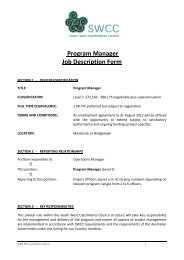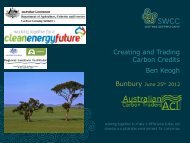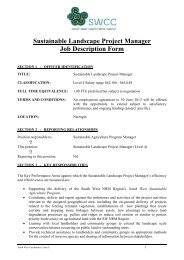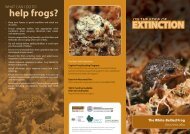Tender for the Programme - South West Catchments Council
Tender for the Programme - South West Catchments Council
Tender for the Programme - South West Catchments Council
You also want an ePaper? Increase the reach of your titles
YUMPU automatically turns print PDFs into web optimized ePapers that Google loves.
DRAFT<br />
<strong>South</strong> <strong>West</strong> Regional NRM Strategy – Ancillary Document<br />
maintaining entire ecosystems in <strong>the</strong> <strong>South</strong> <strong>West</strong> NRM region (http://www.gondwanalink.org/), while <strong>the</strong><br />
Great Eastern Ranges Initiative in eastern Australia spans three States<br />
(http://www.greateasternranges.org.au/).<br />
Benefits of <strong>the</strong> landscape approach extend far beyond conservation, however, with substantial positive<br />
economic spin-offs, e.g. in protecting water supplies and significant nature-based tourism assets. The<br />
maintenance of ecosystem functions and connectivity across landscapes is also recognised as being<br />
essential <strong>for</strong> sustaining <strong>the</strong> health and wellbeing of our rapidly growing human population, particularly with<br />
<strong>the</strong> rapid onset of climate change.<br />
The landscape approach is complex, however, and will require <strong>the</strong> support and participation of individuals,<br />
landholders, communities, industry and government. It will also require better integration and coordination<br />
and management of knowledge, tools, science, planning and funding, as well as increasing awareness<br />
and improving NRM management across all land tenures, all of which requires extensive partnerships.<br />
That said, it should be noted that <strong>the</strong> complexity and size/scale of landscapes can make it difficult to<br />
define <strong>the</strong>m well, resulting in inappropriate management recommendations (Brennan et al 2002). All of<br />
SWCC’s resources will thus need to be coordinated carefully to identify, plan and implement programs<br />
and projects if a landscape-scale approach is to be successfully incorporated into SWCC’s work as a<br />
preferred option <strong>for</strong> achieving lasting change in <strong>the</strong> <strong>South</strong> <strong>West</strong> NRM region.<br />
As a first step, it is <strong>the</strong>re<strong>for</strong>e proposed that SWCC consider setting up a new program to oversee <strong>the</strong><br />
introduction of this approach. This would require human resources with cross-sectoral skills and it might<br />
<strong>the</strong>re<strong>for</strong>e be useful to combine this with <strong>the</strong> realisation of <strong>the</strong> funding and business model described in<br />
Section 5.4, as both require alternative thinking and new funding streams. The following eight guidelines<br />
<strong>for</strong> building successful integrated NRM programs were developed by Frost et al (2006) and <strong>the</strong>y could<br />
<strong>for</strong>m a useful foundation <strong>for</strong> all landscape-scale interventions undertaken by SWCC:<br />
focus on multi-scale analysis and intervention;<br />
develop partnerships and engage in action research;<br />
facilitate change ra<strong>the</strong>r than dictating it;<br />
promote visioning and <strong>the</strong> development of scenarios;<br />
recognize <strong>the</strong> importance of local knowledge;<br />
foster social learning and adaptive management;<br />
concentrate on both people and <strong>the</strong>ir natural resources, including biodiversity; and<br />
embrace complexity.<br />
2.5 The Consultation Process<br />
2.5.1 Stakeholders consulted<br />
The following organisations and people have contributed to <strong>the</strong> evaluation through direct consultation:<br />
Australian Government NRM office – Neil Riches<br />
<strong>South</strong> <strong>West</strong> <strong>Catchments</strong> <strong>Council</strong> – David Gardner (Chair), Damien Postma, Bill Bennell, Leonie Offer<br />
Blackwood Basin Group – Ka<strong>the</strong> Purvis, Felicity Willett<br />
Cape to Cape <strong>Catchments</strong> Group – Rod Whittle, Hayley Rolfe, Cassandra Jury<br />
GeoCatch – Robin Flowers (Chair), Bernie Masters, Sally Clifton-Parks<br />
Leschenault <strong>Catchments</strong> <strong>Council</strong> – Mike Whitehead (Chair), Joanna Hugues-Dit-Ciles<br />
Peel-Harvey <strong>Catchments</strong> <strong>Council</strong> – Jan Star (Chair), Jane O’Malley, Kim Wilson, xxxx<br />
Warren Catchment <strong>Council</strong> – Paul Owens, Lee Fontanini, Andy Russell<br />
<strong>South</strong> <strong>West</strong> Development Commission – Alan Cross<br />
Peel Development Commission – Colleen Yates<br />
WA Local Government Association – Jessica Sheppard<br />
Department of Food and Agriculture WA – Hea<strong>the</strong>r Percy, xxxx<br />
Department of Environment and Conservation – Kim Williams, xxxx<br />
5






